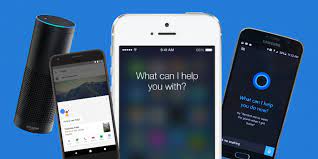In the digital age, the concept of digital assistants has become synonymous with convenience. These AI-powered tools, like Amazon’s Alexa, are designed to simplify our lives, but can they play a crucial role in marketing?
These AI-powered devices are exploding. There are currently over 100 million Alexa devices out there, with consumers increasingly relying on them to search, purchase products, control their homes, and more.
So should brands jump on the voice assistant bandwagon? Are Amazon Echo and Google Home the new digital marketing frontier? Let’s dig in.
The Rise of Voice Assistants
First, let’s get some context on the growth of smart speakers and voice assistants. According to eMarketer, there are 82.4 million voice-enabled devices in the U.S. today. That number is expected to reach over 123 million by 2022.
And it’s not just Alexa and Google Assistant. Apple’s Siri comes installed on millions of iPhones. Samsung Bixby ships with Galaxy devices. Even cars are getting onboard, with voice assistants embedded in infotainment systems.
It’s clear that voice control is becoming a preferred interface for many consumers. Smart speaker ownership has risen over 129% in recent years according to NPR and Edison Research.
As voice assistant usage grows, digital marketers can’t ignore exploring opportunities in this emerging channel.
[OpenAI’s ChatGPT Gets a Voice: Free Voice Features Now Available]
Opportunities for Brands
So what exactly can brands do with digital assistants? Here are some of the marketing capabilities these devices unlock:
- Voice ads – Audio ads users can listen to on Echo devices and third-party podcasts/audio apps.
- Sponsored suggestions – Product/service mentions when users ask questions. E.g. Asking about pizza places prompts a sponsored Pizza Hut suggestion.
- Skill ads – Promoting branded voice skills like “The Capital One Skill” or “The Wendy’s Skill”.
- Skills – Brands can build custom voice apps with Alexa Skills Kit to provide helpful information or experiences like games, quizzes, etc.
- Shopping – Users can add items to their Amazon shopping carts through Alexa. Brands can optimize product information and reviews.
- Flash briefings and podcasts – Curate audio news roundups that promote your brand.
As you can see, voice assistants open up opportunities for audio and conversational advertising beyond traditional visual/text formats.
[Emotion AI tools: Transform User Connections for Businesses]
Benefits for Brands
Leveraging voice technology offers a variety of potential benefits:
- Increased ad visibility – Grabbing attention is tougher with display and social media saturation. A voice breaks through the noise in a new modal.
- Improved brand recall – Hearing information drives 2x higher recall compared to reading according to the Journal of Experimental Psychology.
- Expanded reach – Smart speakers expand reach to existing voice-only audiences like visually impaired and older consumers.
- Deeper engagement – Interactive voice skills can engage users beyond one-way ads.
- Platform growth – Still early days means less competition vs mature channels.
However, as with any new channel, questions remain around effectiveness and ROI.
Concerns and Considerations
Voice marketing comes with its own set of challenges and drawbacks:
- Unclear ROI – As a nascent channel, direct response metrics are still being refined. Difficult to calculate campaign conversions.
- Low usage of voice ads – According to an NPR-Edison Research study, only 36% of smart speaker owners engage with one or more ads per week.
- Low discoverability – Skills are often buried deep in voice assistant apps. Hard for users to find without directly searching.
- Changes to Alexa ad policies – Amazon continually evolves guidelines around sponsorships and disclosures creating uncertainty.
- Privacy concerns – Consumers are still unsure how comfortable they feel sharing data with voice devices.
While the digital assistant arena shows massive potential, marketers considering investing need to test and validate effectiveness against other proven channels.
AI Assistant Guide: Top 10 AI Assistants for Daily and Business Tasks
Tips for Getting Started
If you want to dip your toes into leveraging Alexa and Google Home for marketing, here are some best practices to consider:
- Start with a campaign focused on brand-building vs direct response. Measure engagement metrics and sentiment.
- Put together a small test budget to experiment with voice ads and skills. Measure results before scaling up spending.
- Ensure your brand tone and messaging resonate in an audio environment. Short, conversational copy performs best.
- Promote your voice content across other owned channels – email, social media, blogs etc. Don’t rely solely on digital assistant organic discovery.
- Closely monitor changes to voice assistant advertising policies that may impact sponsored content guidelines.
While still early days, voice technology shows huge promise to reshape digital experiences – both for consumers and brands. As smart speaker adoption grows, marketers must be ready to embrace voice-based marketing tactics.
Just remember to test and validate performance before making any major investments. As with any emerging channel, there will be plenty of lessons to learn!
Have you explored leveraging voice technology for marketing yet?



